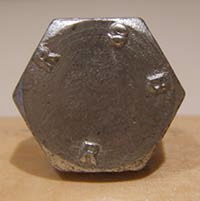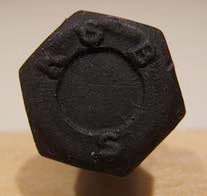None of the fasteners on my Sunbeam are marked with the Society of Automotive Engineers (S.A.E.) markings as described in the August 1984 Newsletter. When replacing O.E.M. bolts with new S.A.E. grade ones, how do I determine which grade to use where?
To answer the question, the British use a different system to grade their fasteners known as the British Unified Series or B.U.S. The sizes and the number of threads per inch are the same, but the grading system is different. The common grades used are Auto R, Auto S and Auto T. See Figure 1 for head identification marks.
Although the B.U.S. system is not directly transferable to the S.A.E. grading system, the table below (Fig. 1) should help you pick out the correct fastener for your application.


| B.U.S. Grade | S.A.E. Replacement |
|---|---|
| AUTO R Very low grade bolt used to hold on such things as your horns or body pieces. | Use S.A.E. Grade 5 Stronger than auto R, but cadmium plated for corrosion resistance and quite inexpensive. |
| AUTO S Hardened bolt | Use S.A.E. Grade 5 Can be used for Auto S except for critical fastening areas such as the driveline or steering. Not quite as strong as Auto S. |
| AUTO T Alloy bolt, used in very high stress areas such as clutch pressure plate to flywheel. | Use S.A.E. Grade 8 or 9· S.A.E. grade is slightly stronger than Auto T. Grade 9 bolts feature higher heads and very high corrosion resistance due to alloy content |
The S.A.E. system only goes up to Grade 8. Bolts above this strength are generally known by the manufacturer’s own designation such as “FEDALLOY” or “PARCOLLOY”. They are marked with 12 slashes on the head or “F9” typically. They offer several advantages; I personally use them almost exclusively even for very low stress applications.
- A higher “crown” or head makes them much more resistant to rounding off by your wrenches.
- Higher grade bolts are much more corrosion resistant. A grade 2 bolt has no corrosion protection, a grade 5 or higher bolt is zinc or cadmium plated and the grade 8 or 9 superbolts are manufactured with an alloy content.
- High grade bolts are stronger. Ham fisted backyard mechanics (most Sunbeam personnel) will have trouble breaking them and, of course, they have an extra safety margin of strength for all applications.
One warning though. Always use nuts and washers of the same grade as the bolt. This can not be over-emphasized. Recently a club member attached the flexplate of his automatic Series IV Alpine with the correct high grade bolts but used low grade washers. As the bolts were torqued, the washers deformed unknown to the owner. After a short distance, they all loosened and several fell right off. Luckily the problem was diagnosed in time and no damage resulted.
